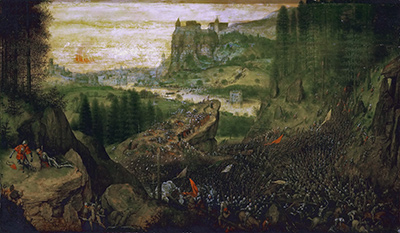The Suicide of Saul was painted by the Netherlandish Renaissance painter and engraver Peter Bruegel the Elder (1525–1569), one of the Bruegel dynasty of painters.
Painted in 1562 while he was in Antwerp, Belgium (Bruegel was a member of the Antwerp painters' guild), this oil-on-panel Northern Renaissance style painting illustrates the biblical story of the suicide of Saul after his defeat by the Philistines (1 Samuel 31, 1-5).
After being severely wounded by archers, Saul realises he is defeated and requests that his armour-bearer kill him. When the armour-bearer refuses, Saul falls on his own sword, thus killing himself.
Saul's death was considered a punishment of pride. The painting depicts the moment of Saul's death with Saul speared by the sword while his armour-bearer helplessly looks on. Swarms of soldiers fill the right hand side of the painting.
Bruegel was a master of religious genre paintings, and he had a tendency to represent biblical stories in the current era in which he was painting. Hence 'The Suicide of Saul' portrays the army in 16th century silver armour uniform.
This painting is an early attempt by Bruegel to reconcile sensitive landscape and figure painting and epitomises his fascination with human folly.
The distant landscape is hazily depicted by pale colours, starkly contrasting against the dark foreground.
Rather than position the subject of the painting in the centre, Bruegel places Saul in the left foreground.
Bruegel's exquisite attention to detail is captured by the hordes of tiny soldiers individually captured within the ravine. He also uses shading to depict the contrasting height of the cliff against the deep ravine.




